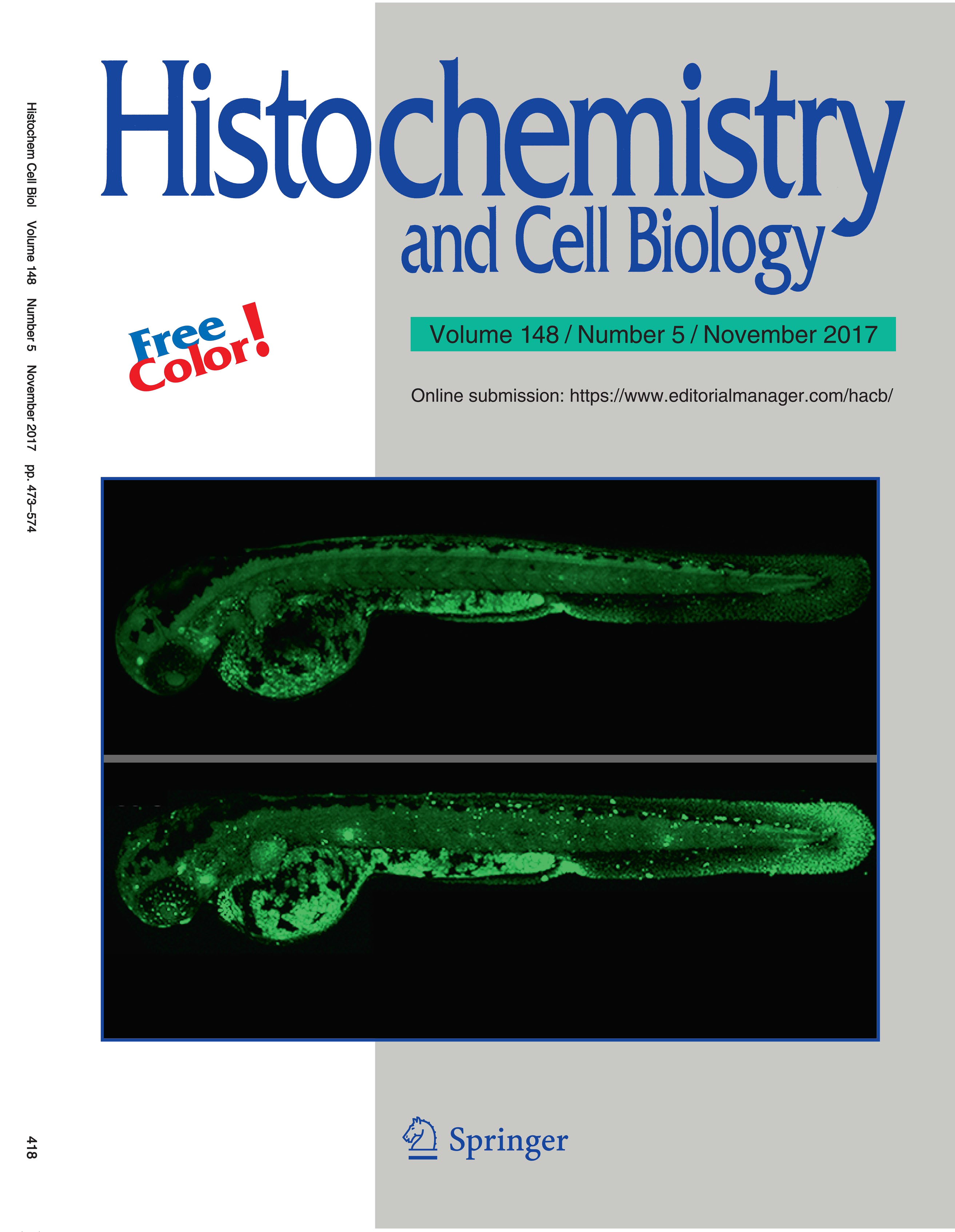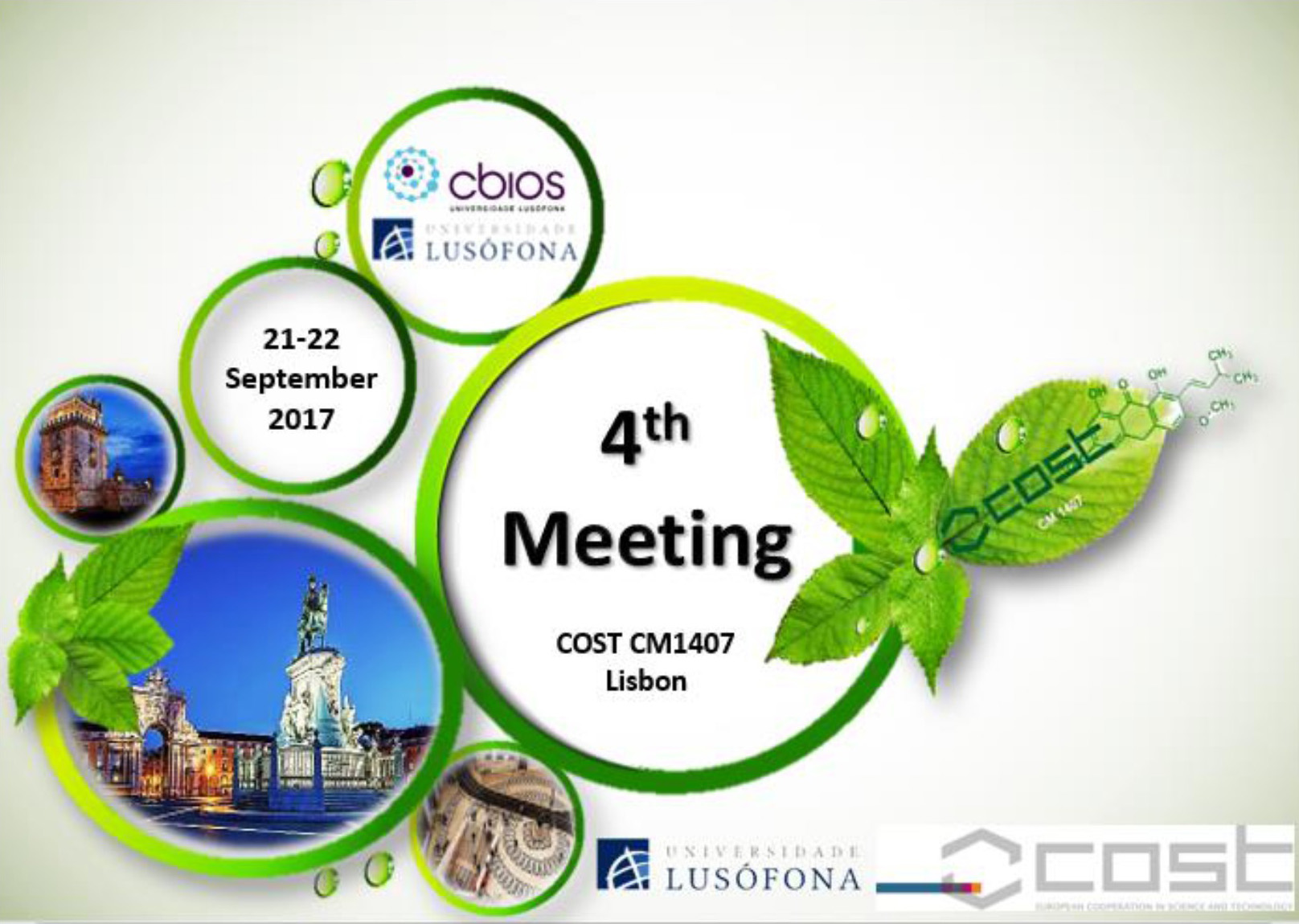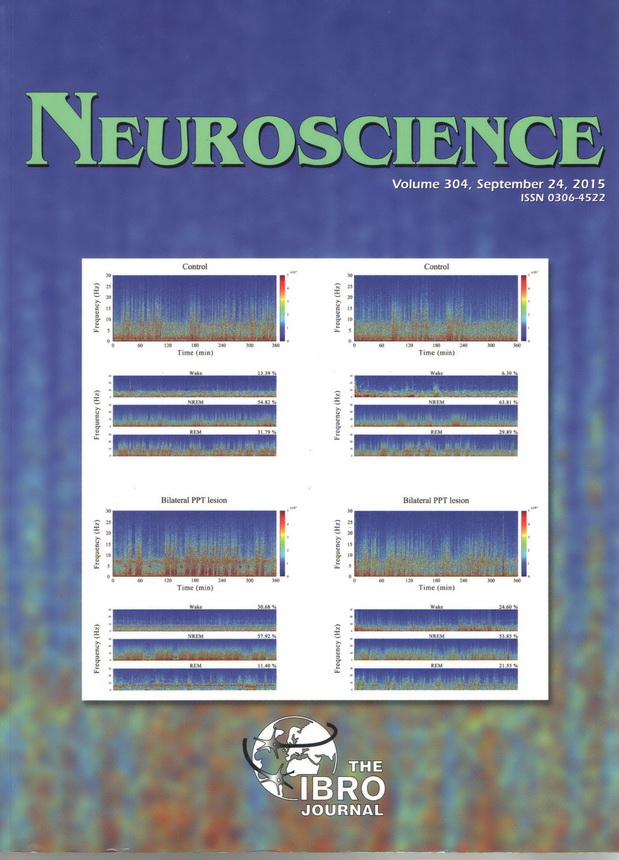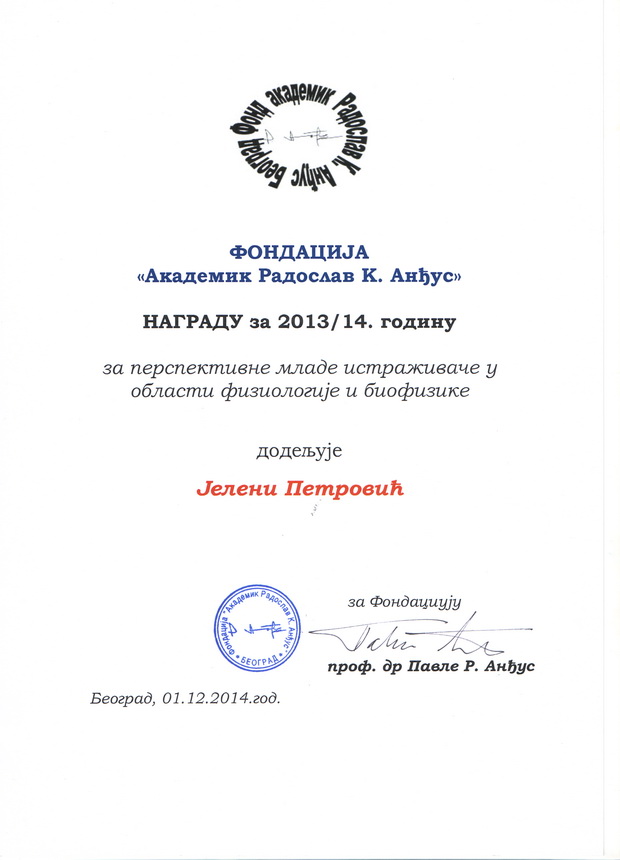Selected publications - The effects of magnetic fields and other environmental stressors on the physiological responses and behavior of different species
Selected publications- The role of autophagy in the regulation of tumor cell death
Selected publications - Neurological development in prenatal exposure to antiepileptic drugs
During the development of new research trends at the Institute, the Department of Cryophysiology under the supervision of Academician Prof. Dr. Radoslav Anđus was established in the early 1960s. Later, the Department of Neurophysiology was established thanks to Dr. Mira Pašić, professor of the Faculty of Biology. The main objective was to examine the neurophysiological basis of behavior at the cellular level.
Using classical electrophysiological techniques (current clamp and voltage clamp), staff of the Department under the supervision of Dr. Gordana Kartelija contributed to establishing the fundamental biophysical properties of individual neurons of the snail Helix pomatia. This research was a starting point for further analysis of functional properties of neurons affected by different active substances and environmental factors (temperature, light, magnetic fields,...) and the mechanisms of neuromodulation.
In addition to classical electrophysiological studies on the snail ganglion complex, recently the biophysical properties of vertebrate nerve cells are analyzed using modern techniques. The patch clamp technique is used to examine the whole-cell ionic currents and the properties of single ion channels in cultured nerve cells.
Electrophysiological signals are analyzed using linear and nonlinear mathematical methods (wavelet and fractal analysis), and advanced statistical methods (independent component analysis). Application of these methods allows detailed analysis of the activity of individual neurons and neuronal populations.
Scientific interest of the Department is extended towards investigation of morpho-functional characteristics of the brain and behavior of experimental animals. The effects of different neuroactive substances, magnetic fields and aging are estimated in physiological and pathophysiological conditions. Neuronal and glial cells are analyzed using immunohistochemical labeling methods and changes of some biochemical parameters in the brain are examined. Animal behavior in specific tests (open field, plus maze, Porsolt forced swim, object recognition, light/dark box,...) is automatically monitored and analyzed using the Any-maze software.
Emphasis is placed on clearly defined neurological and psychiatric diseases in humans. The pathogenic mechanisms involved in the onset of these disorders and pharmacologically active substances which could act protective are studied using animal models (chemically induced seizures for epilepsy and application of aluminum that is associated with the etiology of Alzheimer's disease). These aims are examined on the basis of biochemical and immunohistochemical changes in some brain structures and clinical manifestation of disorders.
GENERAL TOPICS:
Electrophysiology of nerve cells
Analysis of electrophysiological signals
Morpho-functional characteristics of the brain
Animal behavior
Neuroactive substances
Magnetic fields
Animal models
Department of Neurobiology is founded in the early sixties, by Acad. Prof. Ljubisav Rakić at the "Siniša Stanković" Institute for Biological Research, University of Belgrade. During the last 50 years, the investigations at the Department have contributed to the examination of fundamental nervous system processes. Department of Neurobiology consists of the following laboratories: Molecular Neurobiology, Neurochemistry and Neurophysiology, and represents the scientific ground for undergraduate and PhD programs. Presently, there are 40 members of Department. Members of the Department are lecturers at undergraduate and PhD studies (programme: Molecular Biology and Neurosciences) at the Faculty of Biology (BF), University of Belgrade.
The research at the Department is focused on several areas:
Behavioral and electrophysiological studies of the CNS
The biochemical organization of the CNS
Neuroimmunology
Molecular and behavioral studies of brain plasticity
Neurodegenerative diseases of the CNS
Cancer and gene therapy of brain tumors (animal model of multi-drug resistant glioma, mechanisms of multi-drug resistance, new therapeutic approaches)
Biochemical and molecular basis of brain injury and repair
Therapeutical and pharmaceutical approaches in the treatment of CNS disorders
The neurobiology of sleep and sleep-related breathing in the animal models of healthy aging and neurodegenerative diseases, and identification of the neural networks responsible for the regulation of sleep and breathing pattern in different sleep/wake states
Neurobiology of sleep in aging and disease - electroencephalographic markers and modeling in the estimation of disorder #173022
Brain plasticity in aging: effect of dietary restriction and anesthesia #173056
Cellular and molecular basis of neuroinflammation: potential targets for translational medicine and therapy #41014
Identification of Predictive Molecular Markers for Cancer Progression, Response to Therapy and Disease Outcome#41031
In 2020 and 2021, researchers from the Department of Neurobiology at the Institute for Biological Research "Siniša Stanković" - National Institute of Republic of Serbia (Laboratory for Molecular Neuro-Oncology) published 5 papers in the international journal Drug Resistance Updates (IF = 18.5). In Journal Citation Reports, Drug Resistance Updates is ranked among the top 3 journals in its science field (Pharmacology & Pharmacy).
Publications can be found at the following links:
Metal- and metalloid-based compounds to target and reverse cancer multidrug resistance
Repurposing old drugs to fight multidrug resistant cancers
Advanced technological tools to study multidrug resistance in cancer
In vitro biomimetic models for glioblastoma-a promising tool for drug response studies
Don't miss your chance to influence the FENS Regional Meeting 2019 (FRM2019) by submitting a Proposal for Symposia.
FRM2019 will take place in Belgrade, Serbia, July 10-13, 2019 and will be organized by National Neuroscience Societies of Serbia, Romania and Turkey, under the auspices of Federation of European Neuroscience Societies (FENS). Deadline for symposia proposals is September 1st, 2018.
For more information, visit: www.fensfrm2019.rs/symposia/
Dr. Milica Pešić, Dr. Ana Podolski-Renić, Dr. Tijana Stanković, Dr. Jelena Dinić, Dr. Sonja Stojković Burić and Miodrag Dragoj are participants in the COST Action CA17104 STRATAGEM (New diagnostic and therapeutic tools against multidrug resistant tumors) realized in the period from 2018 to 2022 and supported by COST (European Cooperation in Science and Technology). Co-proposer of the Action and Managment Committee (MC) member is Dr. Milica Pešić, while Dr. Ana Podolski-Renić performs the function of the MC substitute.
At the 8th International Conference of Young Scientists and Global Young Academy (GYA) Annual General meeting in Pattaya, Thailand, on May 10th 2018 Dr. Milica Pešić gave a lecture: "Detection and treatment of cancer drug resistance". Dr. Milica Pešić is the leader of GYA Working Groups Biodiversity for Survival via Biomedicine (Bio2Bio) and Women in Science (WiS).
Image from the article: Targeting autophagy to modulate cell survival: a comparative analysis in cancer, normal and embryonic cells, authored by: Aleksandra Divac Rankov, Mila Ljujić, Marija Petrić, Dragica Radojković, Milica Pešić, Jelena Dinić was selected for the cover image of Histochemistry and Cell Biology (Volume 148, Issue 5, November 2017).

At the 3rd Congress of the Serbian Association for Cancer Research, held on 6-7 October 2017, our Institute was a co-organizer. Colleagues from the Department of Neurobiology and Department of Immunology participated in the organization and scientific section of the program on October 7, 2017. The panel discussion was conducted with international guest lecturers (Prof. Ignacio Ochoa Garrido from the University of Zaragoza, Spain, Prof. Engin Ulukaya from Istinye University in Istanbul, Turkey, Prof. Konstantinos Dimas from the University of Thessaly, Greece) and domestic participants from IBISS (Dr. Milica Pešić, Dr. Tijana Stanković, Dr. Sanja Mijatović, Dr. Jelena Dinić, and Dr. Ana Podolski-Renić).
In the photograph during a break between the lectures (from left to right) are: Prof. Engin Ulukaya, Prof. Konstantinos Dimas, Dr. Tijana Stanković, Prof. Ignacio Ochoa Garrido, Dr. Sonja Stojković Burić and Dr. Milica Pešić.

At the 4th Meeting of COST action CM1407 in Lisbon, Dr. Milica Pešić gave a lecture: "Dual inhibitors in cancer tretment".
Dr. Milica Pešić is the leader of Working Group for cancer research within this COST action.
A recording of the lecture is available at the following link: https://drive.google.com/file/d/0B0z9_MnrOvGESDJCOE45UjA4UTQ/view?usp=drive_web
Dr. Vesna Tešić won the prize from "Goran Ljubijankić" Foundation for the best doctoral dissertation in the field of molecular biology for 2015.
Figure 9 of the article entitled Impact of anesthetic regimen on the respiratory pattern, EEG microstructure and sleep in the rat model of cholinergic Parkinson disease neuropathology (Neuroscience, 2015, 304, 1-13) by Lazic K., Petrovic J., Ciric J., Kalauzi A., Saponjic J. was selected for the Cover Winner.

Dr. Zorica Milosevic won the prize from "Goran Ljubijankić" Foundation for the best doctoral dissertation in the field of biology for 2014.
Zorica Milosevic, mentored by Dr. Jasna Banković, successfully defended her doctoral dissertation entitled "The Role of mTOR and MAPK signaling pathways in thyroid cancer resistance" at the Institute for Biological Research "Siniša Stanković", Belgrade.
Dr Jelena Petrovic has been awarded by “Academician Radoslav K. Andjus” Foundation for the best publication in the field of physiology/biophysics in 2013/2014 entitled:
Lesion of the pedunculopontine tegmental nucleus in rat augments cortical activation and disturbs sleep/wake state transitions structure, Experimental Neurology, 2013, 247, 562-571, by Petrovic Ј, Ciric Ј, Lazic К, Kalauzi А, Saponjic Ј.

16.11.2014 - 12.04.2014 Dr. Ana Martins (Department of Medical Microbiology and Immunobiology, University of Szeged, Hungary) resided on training in methods for the detection of multi-drug resistance in cancer at the Department of Neurobiology under the supervision of Dr. Milica Pešić.
Dr. Ana Podolski-Renić won the first place in the competition for the best poster presentation entitled "Influence of MDR cancer phenotype on the efficacy of novel tubulin destabilizing agent DTA0100" at a meeting of COST CM1106 (http://www.stemchem.org) "2nd Workshop, 14 - 15 October 2014 Tenerife - Puerto de la Cruz, Spain."
27.06.2014. Dr. Nikola Tanić, a Research Fellow at the Institute for Biological Research "Siniša Stanković", Belgrade, became a new team member of the Ministry of Education, Science and Technological Development. He holds the position of an assistant minister for the basic research and development of human resources in science.
Dr. Milica Pešić has become one of the 200 members of the "Global Academy youth" (Global Young Academy - GYA), an organization that recognizes the best scientists from around the world at the beginning of their careers.
Dr Ana Podolski-Renić was awarded by "Goran Ljubijankić" Foundation for the best doctoral dissertation (entitled "Establishment of resistant tumor cell lines as a model for testing new chemotherapeutics: molecular characterization of resistance caused by long term exposure to paclitaxel") in the field of biology for 2013.
Dr. Milica Pešić, Dr. Jasna Banković, Dr. Nikola Tanić and Dr. Sabera Ruždijić are co-inventors of the patent WO/2011/139172: DITERPENE COMPOUNDS WITH ANTINEOPLASTIC ACTIVITIES AND PHARMACEUTICAL COMPOSITIONS COMPRISING SAME
Members of the team NEUROBIOS leaded by prof Mirjana Stojiljkovic won Diploma for participation in the final competition for "Best Technological Innovation in Serbia 2010", in the category REALIZED INNOVATIONS.
Members of the team NEUROBIOS leaded by prof Mirjana Stojiljkovic won the second prize at the Competition for the "Best Technological Innovation in Serbia 2009", in the category POTENTIALS.
Members of the team leaded by Dr. Sabere Ruzdijic won the second prize at the Competition for the "Best Technological Innovation in Serbia 2008", in the category POTENTIALS.
Part of the results of Laboratory for Neurochemistry won the first place at the International Festival of Innovations, Knowledge and Creativity – TESLA FEST and received Diploma and golden plaque of the Society of Inventors of Vojvodina.
1. Mujić A, Grdović N, Mujić I, Mihailović M, Živković J, Poznanović G, Vidaković M. Antioxidative effects of phenolic extracts from chestnut leaves, catkins and spiny burs in streptozotocin-treated rat pancreatic β-cells. Food Chem. 2011;125:841-9.
2. Mihailović M, Arambašić J, Uskoković A, Dinić S, Grdović N, Marković J, Poznanović G, Vidaković M. Alpha-lipoic acid preserves the structural and functional integrity of red blood cells by adjusting the redox disturbance and decreasing O-GlcNAc modifications of antioxidant enzymes and heat shock proteins in diabetic rats. Eur J Nutr. 2012;51:975-86.
3. Grdović N, Dinić S, Arambašić A, Mihailović M, Uskoković A, Marković J, Poznanović G, Vidović S, Zekovic Z, Mujić A, Mujić I. Vidaković M. The protective effect of a mix of Lactarius deterrimus and Castanea sativa extracts on streptozotocin-induced oxidative stress and pancreatic β-cell death. British J Nutr. 2012;108:1163-76.
4. Arambašić J, Mihailović M, Uskoković A, Dinić S, Grdović N, Marković J, Poznanović G, Bajec Đ, Vidaković M. Alpha-lipoic acid upregulates antioxidant enzyme gene expression and enzymatic activity in diabetic rat kidneys through an O-GlcNAc-dependent mechanism. Eur J Nutr. 2013;52(5):1461-73.
5. Doetsch M, Gluch A, Poznanović G, Bode J, Vidaković M. YY1-binding sites provide central switch functions in the PARP-1 gene expression network. PLoS One. 2012;7(8):e44125.
7. Dinić S, Uskoković A, Mihailović M, Grdović N, Arambašić J, Marković J, Poznanović G, Vidaković M. Ameliorating effects of antioxidative compounds from four plant extracts in experimental models of diabetes. J Serb Chem Soc. 2013;78(3):365-80.
8. Arambašić J, Mihailović M, Uskoković A, Dinić S, Grdović N, Marković J, Poznanović G, Bajec Đ, Vidaković M. Alpha-lipoic acid upregulates antioxidant enzyme gene expression and enzymatic activity in diabetic rat kidneys through an O-GlcNAc-dependent mechanism. Eur J Nutr. 2013;52(5):1461-73.
9. Marković J, Grdović N, Dinić S, Karan-Đurašević T, Uskoković A, Arambašić J, Mihailović M, Pavlović S, Poznanović G, Vidaković M. PARP-1 and YY1 are important novel regulators of CXCL12 gene transcription in rat pancreatic beta cells. PLoS One. 2013;8(3):e59679.
10. Dinić S, Arambašić J, Mihailović M, Uskoković A, Grdović N, Marković J, Karadžić B, Poznanović G, Vidaković M. O-GlcNAcylation of the key proteins in the kinase and redox signalling pathways is a novel mechanism of the beneficial effect of α-lipoic-acid in diabetic liver. Brit J Nutr. 2013;110(3):401-12.
11. Mihailović M, Arambašić J, Uskoković A, Dinić S, Grdović N, Marković J, Poznanović G, Ibrahim M, Vidaković M. β-glucan administration to diabetic rats reestablishes redox balance and stimulates cellular pro-survival mechanisms. J. Funct Foods. 2013;5(1):267-78.
12. Mihailović M, Arambašić J, Uskoković A, Dinić S, Grdović N, Marković J, Bauder J, Poznanović G, Vidaković M. β-Glucan administration to diabetic rats alleviates oxidative stress by lowering hyperglycaemia, decreasing non-enzymatic glycation and protein O-GlcNAcylation. J Funct Foods. 2013;5(3):1226-34.
13. Uskoković A, Mihailović M, Dinić S, Arambašić J, Grdović N, Marković J, Poznanović G, Vidaković M. Administration of a β-glucan-enriched extract activates beneficial hepatic antioxidant and anti-inflammatory mechanisms in streptozotocin-induced diabetic rats. J Funct Foods. 2013;5(4):1966-74.
14. Grdović N, Dinić S, Mihailović M, Uskoković A, Arambašić Jovanović J, Poznanović G, Wagner L, Vidaković M. CXC chemokine ligand 12 protects pancreatic β-cells from necrosis through Akt kinase-mediated modulation of poly(ADP-ribose) polymerase-1 activity. PLOS One. 2014;9(7):e101172.
15. Ivanović-Matić S, Mihailović M, Dinić S, Martinović V, Bogojević D, Grigorov I. Poznanović G. The absence of cardiomyopathy is accompanied by increased activities of CAT, MnSOD and GST in long-term diabetes in rats. J Physiol Sci. 2010;60(4):259-66.
16. Arambašić J, Poznanović G, Ivanović-Matić S, Bogojević D, Mihailović M, Uskoković A. Grigorov I. Association of the Glucocorticoid Receptor with STAT3, C/EBPß and the hormone responsive element within the rat haptoglobin gene promoter during the acute phase response. IUBMB Life. 2010;62(3):227-36.
17. Matić S, Stanić S, Bogojević D, Vidaković M, Grdović N, Arambašić J, Dinić S, Uskoković A, Poznanović G, Solujić S, Mladenović M, Marković J. Mihailović M. Extract of the plant Cotinus coggygria Scop. attenuates pyrogallol-induced hepatic oxidative stress in Wistar rats. Can J Physiol Pharmacol. 2011;89(6):401-11.
18. Milošević VLj, Ajdžanović VZ, Bogojević DB, Medigović IM, Ivanović-Matić SK, Martinović VI, Grigorov I. The effect of chronic food restriction on immunopositive ACTH cells in peripubertal female rats. Gen Physiol Biophys. 2011;30(3):321-324.
19. Martinović V, Grigorov I, Bogojević D, Petrović A, Jovanović S, Ilić M, Ivanović-Matić S. Activation level of JNK and Akt/ERK signaling pathways determinates extent of DNA damage in the liver of diabetic rats. Cell Physiol Biochem. 2012;30(3):723-34.
20. Uskoković A, Dinić S, Mihailović M, Grdović N, Arambašić J, Vidaković M, Bogojević D, Ivanović-Matić S, Martinović V, Petrović M, Poznanović G, Grigorov I. STAT3/NF-κB interactions determine the level of haptoglobin expression in male rats exposed to dietary restriction and/or acute phase stimuli. Mol Biol Rep. 2012;39(1):167-76.
21. Arambašić J, Mihailović M, Bogojević D, Ivanović-Matić S, Uskoković A, Poznanović G, Grigorov I. Haptoglobin and the inflammatory and oxidative status in experimental diabetic rats: antioxidant role of haptoglobin. J Physiol Biochem. 2013;69(1):45-58.
22. Martinović V, Bogojević D, Jovanović S, Petrović A, Ivanović-Matić S, Zolotarevski L, Poznanović G, Grigorov I. Hepatoprotective effects of melatonin against pronecrotic cellular events in streptozotocin-induced diabetic rats. J Physiol Biochem. 2014;70(2):441-50.
IBISS uses analytical cookies to analyze the use of the site in order to improve the user experience, by clicking "Accept" you consent to the use of cookies.